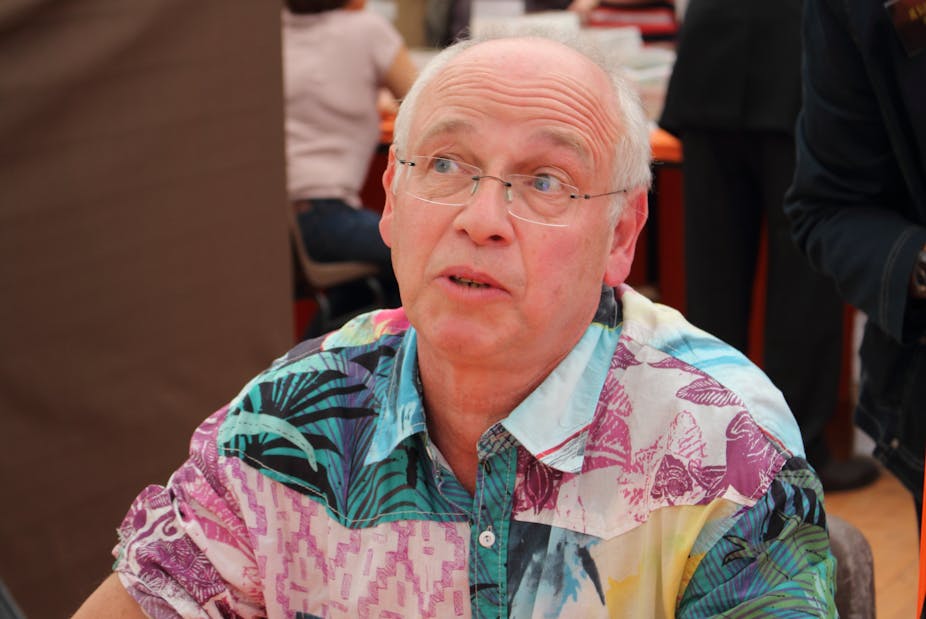The French true crime writer Stéphane Bourgoin’s trained at the FBI’s profiling school in Virginia and had interviewed 77 murderers, including Charles Manson and Ted Bundy. He had advised the FBI and Scotland Yard on difficult cases and his own wife had been murdered by a serial killer. He even had a short stint as a professional footballer for the Parisian team Red Star. His life seemed as interesting as one of his 40 books. Except none of it was true.
Following an investigation by the anonymous collective 4ème Oeil (Fourth Eye) Corporation in February on YouTube, Bourgoin was forced to admit he had fabricated much of his life story and CV.
This is not the first time a French author has fabricated a wild and interesting life. Some have done it to make a book more attractive to readers and awards committees. Others have done it to distance themselves from lowly roots and a back catalogue of pulpy fiction.
Embroidering the truth
Bourgoin has since admitted that the fictitious wife was based on a woman he met “five or six times” and “liked”. He did briefly meet Charles Manson, but only walked past him and never got to speak to his. And, instead of 77 murderers, he had only spoken to around 30.
In a series of interviews with French newspapers, Bourgoin now says he should have let his real knowledge stand for itself – that his books were good enough to sell without such a fantastical back story.
Writers have long used false histories and fabricated public personas to their own ends, especially if that’s what it takes to get a publishing deal or public recognition.
One of the most notorious incidences involves the Prix Goncourt, France’s most prestigious literary prize, which is awarded to “the best and most imaginative prose work of the year”. Previous winners include Marcel Proust and Simone de Beauvoir.
It can only be won once. But the prolific writer Romain Gary managed to win it twice through a feat of deception, first in 1956 for Les racines du ciel (The Roots of Heaven), and then as the supposedly Algerian writer Émile Ajar in 1975 for Gros-Câlin.
His deception was only confirmed posthumously in the publication of a confession Vie et mort d’Émile Ajar (The Life and Death of Émile Ajar). Throughout his lifetime, Gary wrote under several names, including Fosco Sinibali, Shatan Bogat and Roman Kacew (his birth name).
Even one of France’s most revered writers, Honoré de Balzac, was not immune to a certain propensity for exaggerating the truth when crafting his public and private image.
Balzac is perhaps best known as one of the founders of literary realism. However, he started his career churning out potboilers under pseudonyms (one of which was Lord R’Hoone, an anagram of Honoré, and Horace de Saint-Aubin).

Later, to disassociate himself from these early publications, he had his assistant write a preface to his novel La Dernière Fée (The Last Fairy, 1823) in which Horace de Saint-Aubin meets the new, successful Balzac and, upon reading a few pages of the latter’s writing, is so depressed that he sets his own novels on fire.
To complete the transformation, he added an aristocratic-sounding particle to become “de” to Balzac. The surname itself was a creation, changed by his father from the more common-sounding Balssa in an attempt to move the family on from its peasant roots, and hinting at an illusory connection with the illustrious Balzac d’Entragues family.
It also so happens that it was a French writer, Serge Doubrovsky, who in the 1970s coined the term “autofiction” (fiction of the self) to describe his 1977 novel Fils (Son). The protagonist of Fils shares the author’s name and certain key characteristics, yet exists in an essentially fictional space. Doubrovsky described autofiction as “fiction, made up of events and facts that are strictly real”.
The term creates a problem from the not-so-straightforward relationship between autobiography and truth. In the words of the academic Alex Hughes, autofiction allows the author to transmit biographical facts “in a narrative format whose novelistic tenor permits him not to assume responsibility” for the truthfulness of his statements. Were he claiming to write within this genre, Bourgoin might have a leg to stand on. As things are, his books are on the wrong shelf.
Moral outrage
What is perhaps most interesting about Bourgoin’s story is the keenness with which his fabrications were seized on. His exaggerations enhanced his credibility and opened doors for him. It’s as if Bourgoin sensed that by exaggerating certain specific details, and thereby producing a particular kind of narrative, he was giving the public what he knew they really wanted to hear all along.
As the critic Pierre Bourdieu pointed out in 1986, one problem with autobiography is that we all have been so exposed to the narrative conventions of fiction that we will almost inevitably reproduce them in the life story we write – even though this is likely to lead to misrepresenting the historical reality.
In writing himself into his books as the bereaved hero, Bourgoin was tapping into powerful patterns of storytelling that his readers were already attuned to. In The Science of Storytelling, the writer Will Storr suggests that the brain is primed to react with interest to stories of “moral outrage”, which Storr calls “the ancient lifeblood of storytelling”. When we see heroes squaring up to face baddies, our tribal instinct for justice kicks in and we root for Bourgoin’s fictitious alter-ego.
With Bourgoin’s confession, his narrative now unfolds anew. “When you’ve broken a character you can begin to build their story,” writes Storr. We want to see the bad guys punished, or at least remorseful. Bourgoin, and the organisation that exposed his fabricated claims, have unwittingly provided just that to our story-hungry brains. We readers have been had. And, to borrow Storr’s expression, “we’re fucking outraged.”


